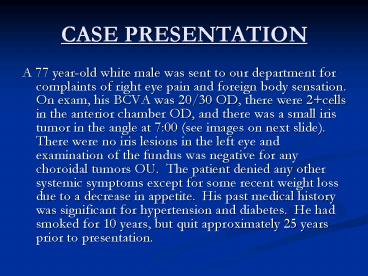CASE PRESENTATION - PowerPoint PPT Presentation
1 / 12
Title:
CASE PRESENTATION
Description:
On exam, his BCVA was 20/30 OD, there were 2 cells in the anterior chamber OD, ... It is not uncommon for iritis, hyphemas, and ocular hypertension to occur ... – PowerPoint PPT presentation
Number of Views:59
Avg rating:3.0/5.0
Title: CASE PRESENTATION
1
CASE PRESENTATION
- A 77 year-old white male was sent to our
department for complaints of right eye pain and
foreign body sensation. On exam, his BCVA was
20/30 OD, there were 2cells in the anterior
chamber OD, and there was a small iris tumor in
the angle at 700 (see images on next slide).
There were no iris lesions in the left eye and
examination of the fundus was negative for any
choroidal tumors OU. The patient denied any
other systemic symptoms except for some recent
weight loss due to a decrease in appetite. His
past medical history was significant for
hypertension and diabetes. He had smoked for 10
years, but quit approximately 25 years prior to
presentation.
2
(No Transcript)
3
- The differential diagnosis at this point was an
amelanotic melanoma versus a metastatic lesion.
An anterior chamber tap was performed to see if
the tumor could be identified by any possible
tumor cells in the anterior chamber. However,
cytology only showed lymphocytes. Thus, the next
step was to do a fine needle biopsy of the
lesion. However, after just 6 days, there was
significant growth of the tumor (see image on
next slide), leading us to feel that this was
much more likely a metastatic lesion than a
melanoma. Thus a systemic work-up was requested.
- CT scan of the chest and abdomen revealed diffuse
thickening of the esophagus from just above the
carina down to the gastroesophageal junction.
There were also multiple bilateral pulmonary
metastases (too many to count), ranging in size
from 2mm to 2cm. An MRI of the brain and orbits
was negative. PET scan was refused by insurance.
Biopsy of the esophageal lesion revealed poorly
differentiated squamous cell carcinoma. Thus,
the patient was diagnosed with stage IV
metastatic esophageal carcinoma.
4
(No Transcript)
5
- The iris tumor continued to grow larger in the
right eye (4.7mm x 2.4mm), to the point that
there was endothelial touch with associated focal
corneal edema (see image 4). There was a
subsequent worsening of anterior uveitis and
ocular hypertension (28mm Hg). This was
relatively controlled with topical medications. - The patient underwent his first dose of
chemotherapy (Cisplatin and Taxotere) 26 days
after initial presentation. Ophthalmic exam ten
days later already showed some reduction in the
size of the tumor (See image 5). By thirty-two
days out from the first chemotherapy treatment
(eleven days after the second treatment), the
iris tumor was down to 1.0mm x 1.5mm in size.
After the third treatment, the iris lesion was
barely visible.
6
- Image 4
7
- Image 5
8
- Unfortunately, about 6 weeks after his sixth and
final chemotherapy treatment, follow-up
examination showed that the iris tumor was
definitely recurring and growing (see image on
next slide). A hyphema developed, which slowly
resolved, and the ocular hypertension
significantly worsened. His IOP was 28 on
maximum medical therapy. - The Oncology department decided that further
chemotherapy was not warranted. The option of
palliative radiation therapy focally to the iris
tumor was addressed, but the patient declined.
The patients eye was kept relatively comfortable
with medical management. Eight months after
presentation, the patient passed away.
9
(No Transcript)
10
DISCUSSION
- Metastatic esophageal carcinoma to the iris is
extremely rare. There are only three reported
cases in the literature1-3. However, the case
weve presented is the only reported case where
the presenting signs and symptoms of the
esophageal carcinoma occurred in the eye
(secondary to metastasis). - As was the case with our patient, the prognosis
for metastatic esophageal carcinoma to the eye is
quite poor. Our patient initially responded very
well to chemotherapy. However, the disease
process was too progressed by the time
chemotherapy was initiated to be able to
eradicate the disease, as is usually the
situation in such cases.
11
- Fine-needle biopsy can be very helpful in the
diagnosis of iris tumors when the type of tumor
is unknown. This was not necessary in this case,
as the diagnosis was evident after rapid growth
of the iris tumor triggered an extensive systemic
work-up, showing that an occult esophageal
carcinoma was the focus of a metastatic disease. - It is not uncommon for iritis, hyphemas, and
ocular hypertension to occur secondary to iris
tumors. The mechanism of ocular hypertension is
secondary to inflammatory and red blood cells
clogging the trabecular meshwork and tumor growth
into the angle.
12
- In cases such as this one, if the tumor is not
able to be controlled with chemotherapy, focal
radiation therapy can be a good palliative option
to control the tumor to keep the eye comfortable.
If the patient does not agree to radiation
treatment, if the prognosis is very poor, and if
the patient is experiencing uncontrollable ocular
pain, enucleation is another palliative option. - In a series of metastatic iris tumors seen at
Wills Eye Hospital2, sixty-eight percent of
patients had a known primary cancer at the time
of presentation for signs and symptoms of iris
metastases. The case described above is very
unique in that, not only was the primary cancer
not known, but it is the only reported case of
esophageal cancer where the presenting signs and
symptoms were ocular in nature.
- REFERENCES
- 1. Segal A, Ducasse A, Mathot E, Jouhaud F.
Metastase Irienne DUn Cancer De LOesophage.
Bull Soc Ophtalmol Fr 1978 Jan87(1)137-9. - 2. Shields JA, Shields CL, Kiratli H, de Potter
P. Metastatic Tumors to the Iris in 40 Patients.
Am J Ophthalmol. 1995 Apr119(4)422-30. - 3. Shields CL, Shields JA, Gross NE, Schwartz GP,
Lally SE. Survey of 520 Eyes with Uveal
Metastases. Ophthalmology. 1997
Aug104(8)1265-76.

